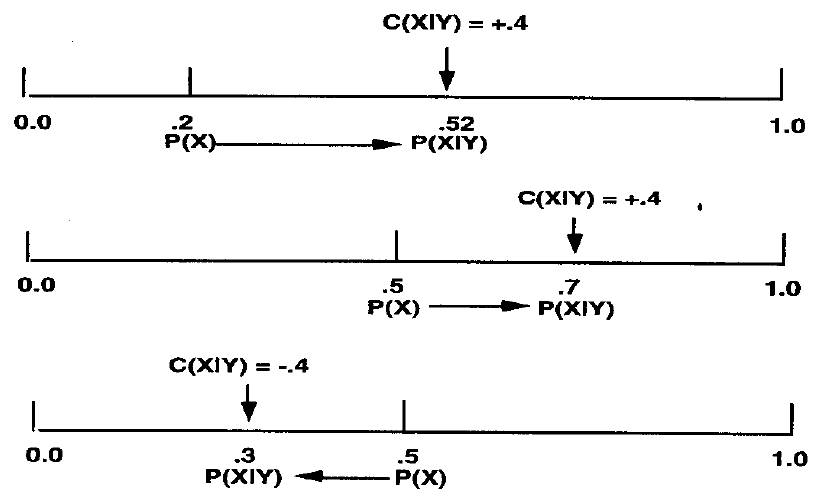In addition to the DeMorgan gate, QGeNIe implements another interaction model: the CAST gate (Chang 1994). CAST stands for CAusal STrengths logic. We have attempted to find a probabilistic interpretation of the CAST gate and we think that it is challenging with non-obvious meaning of its parameters. Still, CAST gate has been used widely, especially in military applications, through two programs popular in 1990s, SIAM and Causeway, both apparently no longer available. While interesting and useful in practice, we believe that in the context of probabilistic models, the CAST gate is semantically less clear than the DeMorgan gate and we found that it sometimes causes problems with knowledge elicitation from experts, especially around CAST's baseline probability (discussed below). We have implemented it in QGeNIe for the sake of completeness and compatibility with existing models and software, although we do not allow for combining DeMorgan and CAST gates in the same model, so the user has to choose whether he/she is modeling using DeMorgan gates of the CAST gates.
We focus in this section on the CAST gate, providing definitions and descriptions of the CAST parameters. Because this section is necessarily brief, we refer interested readers to the paper by Chang (1994).
Baseline probability
Similarly to the DeMorgan gate, every CAST node is characterized by a parameter called baseline probability. For nodes without parents, this parameter has a fairly clear probabilistic interpretation and is simply the prior probability of the proposition represented by the node.
However, when the node has parents, the baseline probability can no longer be interpreted as the prior probability of the proposition. It cannot be given the interpretation of a leak parameter. Only jointly with a specification of the influence of parents, causal strengths (described in the next paragraph), it is possible to derive conditional probability distributions over the node, something that a probabilistic model needs.
It would be fair to state that the baseline probability P(X) is the probability of a proposition X when it is isolated from influences of any other modeled variables, so it is close to the marginal probability of X.
Causal strengths
Every arc connecting a pair of CAST nodes is described by two parameters, which are called causal strengths. Causal strengths take values from the interval [-1..1]. They are not probabilities but rather an expression of fractional change in the baseline probability of the child node as an effect of the parent node being True or False respectively. Because they can take both positive and negative values, they are convenient in describing positive or negative character of influences.
The following figure from (Chang 1994, Figure 2.3) illustrates the meaning of causal strengths associated with an influence of a variable Y on a variable X:

Causal strength C(X|Y) expresses the percentage of change of the baseline probability toward the extremes (0 and 1). When positive, its value tells us the percentage of change from the current probability p toward the probability 1.0. When negative, it expresses the percentage of change from the current probability p toward the probability 0.0. The top part of the figure shows what happens when the baseline P(X)=0.2 and C(X|Y)=0.4. In this case, the probability of X changes from its original value of 0.2 to 0.2+(1.0-0.2)*0.4=0.52. The middle part of the figure shows what happens when the baseline P(X)=0.5. In this case, the probability of X changes from its original value of 0.5 to 0.5+(1.0-0.5)*0.4=0.7. Finally, the bottom part of the figure shows what happens when the baseline P(X)=0.5 gets affected by a negative causal strength C(X|Y)=-0.4. In this case, the probability of X changes from its original value of 0.5 to 0.5-(0.5-0.0)*0.4=0.3.
Aggregation of causal strengths
Causal strengths, similarly to parameters in the DeMorgan gate, describe individual influences that neighboring nodes have on each other. This allows for a concise description of how a node is effected by its parents. When multiple parents are present, the CAST logic determines how their influences are combined with each other. Combining positive influences is quite straightforward and so is combining negative influences. Calculation of a mixture of positive and negative influences is more problematic, although resting on reasonable heuristic assumptions.